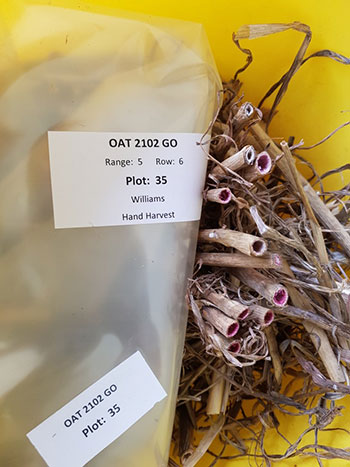Key points
- In a year with above-average rainfall and mild temperatures during grain fill, oats showed reduced yield loss from Fusarium crown rot compared with wheat and barley
- This one-year study has shown little variation in Fusarium crown rot tolerance across nine oat varieties
Over the past decades, Fusarium crown rot (FCR) has become one of the most important diseases of cereal crops across Australia.
Predominantly caused by Fusarium pseudograminearum – although F. culmorum can also be important in higher-rainfall areas in the southern region – FCR is a stubble-borne disease. Its prevalence has increased with the widespread adoption of stubble retention cropping practices and increasing cereal frequency in cropping systems. However, little is known about the role oats could play harbouring the fungal inoculum in cropping systems.
Through the Grains Agronomy and Pathology Partnership (GAPP) co-investment project, supported by the NSW Department of Primary Industries and GRDC, trials were undertaken to test whether oats had the potential to manage FCR in NSW cropping systems.
Three questions were addressed:
- Are oats more tolerant to FCR than wheat or barley?
- Do oat varieties vary in tolerance?
- Is persistence of stubble-borne inoculum following crop harvest shorter with oats, providing a paddock management benefit?
Further research is required, but it appears that the findings of this preliminary one-year study indicate that oats could provide some benefit in reducing in-crop yield loss from FCR compared to other cereals. However, oats might not necessarily reduce paddock inoculum levels or, therefore, FCR risk within NSW farming systems.
Table 1: Cereal varieties used in the experiments, listed from quick to slow season. Source: NSW DPI
Oat varieties | Durack , Mitika , Kowari , Yallara , Bilby , Bannister , Williams , Koala , Yarran (winter type) |
Wheat varieties | Vixen , Sunmaster , Beckom |
Barley varieties | LaTrobe, Laperouse , RGT Planet |
Source : NSW DPI
About the experiments
Trial sites were established at Goonumbla and Gilgandra in 2021.The experimental treatments covered cereal species comparison (oats versus wheat versus barley) with plus and minus FCR inoculation in split plots (two grams per metre of row in inoculated plots, a mixture of five Fusarium pseudograminearum isolates).
There were nine oat varieties differing in plant architecture and phenology (quick-slow season types), together with three wheat and three barley varieties matching phenology groups from quick through to slow (Table 1).
The season was characterised by above-average rainfall and mild spring conditions, with Gilgandra recording rainfall based on long-term Bureau of Meteorology (BoM) records in the 95th percentile and Parkes (closest BoM weather station to the Goonumbla site) in the 85th percentile.
Through the critical flowering and grain-filling period of September, October and November, Gilgandra received 70, 3 and 370 per cent respectively above the long-term monthly rainfall averages, with Parkes 64, −28 and 201 per cent respectively. At both sites the trials were not moisture-stressed during this critical period, with good soil moisture reserves and timely in-crop rainfall.
 Figure 1: Williams oat stubble showing the typical pink fungal growth in stems infected with Fusarium crown rot from the Goonumbla site in 2021. Photo: NSW DPI
Figure 1: Williams oat stubble showing the typical pink fungal growth in stems infected with Fusarium crown rot from the Goonumbla site in 2021. Photo: NSW DPI
With the good seasonal conditions, above-average yields were achieved at both sites, with an average site yield at Goonumbla of 6.08 tonnes per hectare and at Gilgandra 6.06t/ha. These good seasonal conditions severely restricted FCR expression and, therefore, the ability to draw robust conclusions from a single year of experimentation.
Stubble-borne inoculum levels at harvest and following a summer fallow period between oats, wheat and barley plants showed little difference at either the Goonumbla or Gilgandra sites when inoculated at sowing with FCR. However, there were differences for tolerance to FCR with oats versus wheat and barley at the Gilgandra site, with FCR reducing grain yield of the wheat-barley inoculated treatments by 4.7 per cent (Figure 1). This provides some evidence that oats could have improved tolerance (that is, reduced grain yield loss) to FCR compared with bread wheat and barley.
FCR did not significantly affect grain quality, with only minor variety effects seen for seed size at Goonumbla and screening levels at Gilgandra. This is expected given the good rainfall at the end of the season, which limited the usual negative effect of FCR infection on water flow through the plant stems.
Oat FCR varietal differences
Of the nine oat varieties tested in 2021, no differences were seen between varieties for plant infection at the two sites. This will limit a grower’s ability to select an oat variety with improved tolerance to FCR, as they can when choosing bread wheats and barley varieties.
There could be an opportunity for early generation screening for FCR in the national oat breeding program, or screening overseas germplasm for FCR tolerance, as the disease becomes a bigger issue in southern farming systems with the continued adoption of conservation cropping practices.
Further research
Research in a low-to-average rainfall season that favours FCR expression is needed to confirm the difference between yield loss in wheat and barley compared with oats, as indicated in this single-year study with above-average rainfall. If improved tolerance to FCR infection in oats (reduced yield loss) can be confirmed, it could offer growers a crop choice for paddocks where FCR levels are above risk levels for wheat or barley, providing another lower-risk cash crop in their rotation.
However, growers would need to be aware that while the production of oats in this situation might increase profitability in that individual season, it appears to increase or maintain stubble-borne FCR inoculum loads for subsequent winter cereal crops within the farming system.
More information: Peter Matthews, 0427 007 395, peter.matthews@dpi.nsw.gov.au

























































